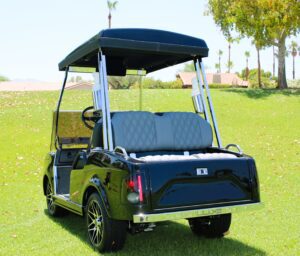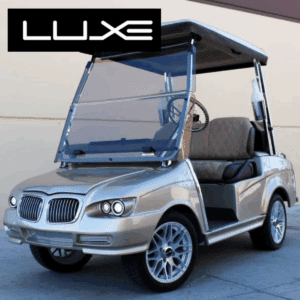Top 10 Questions to Ask Before Buying a Golf Cart—that phrase is more than a checklist; it’s your framework for a confident, luxury-grade purchase. Whether you’re cruising your gated community, teeing off on a private course, or running neighborhood errands in the Coachella Valley, the right all-electric cart should blend quiet performance, refined comfort, and low-maintenance ownership. The wrong choice can mean avoidable costs, disappointing range, or compliance headaches. This guide gives you direct, expert answers—written for discerning buyers who value quality, reliability, and service.
Read more: How Often Should I Add Water to Golf Cart Batteries?
1) Which battery chemistry is right for me: lithium or lead-acid?
Short answer: Choose lithium if you want premium performance with minimal maintenance; consider lead-acid for lower upfront cost if budget is the priority.
What to know:
- Lithium (LiFePO₄): Lighter weight for better acceleration and hill performance; typically thousands of cycles; maintenance-free; fast charging; stable voltage for consistent power delivery; excellent long-term value and resale.
- Lead-acid (Flooded/AGM/Gel): Lower upfront price; heavier; slower charging; periodic maintenance for flooded types (watering/cleaning terminals); voltage sag under load; typically shorter cycle life.
Ask the dealer:
- Cycle life warranty in years AND expected charge cycles.
- Battery management system (BMS) details and protections.
- Pack size (Ah/Wh), expected real-world range, and charging time on 120V and (if available) 240V.
- Replacement battery pricing and availability 5–8 years out.
Read more: Golf Cart Range: How Far Can Your Electric Cart Go on a Single Charge?
2) What range do I realistically need—and under what conditions?
 Short answer: Calculate your longest typical day and add a 25–35% buffer for hills, passengers, cargo, and accessory use.
Short answer: Calculate your longest typical day and add a 25–35% buffer for hills, passengers, cargo, and accessory use.
What affects range:
- Terrain and elevation in your community (hills in La Quinta neighborhoods vs. flat fairways).
- Passenger count and weight.
- Stop-and-go use vs. steady cruising.
- Accessory draws (lights, audio, refrigeration, under-glow, etc.).
- Ambient temperature (desert heat can affect performance profiles).
Ask for:
- Dealer-verified range at your expected load and speed, not brochure maximums.
- A test route that mirrors your daily use in the Coachella Valley.
- Written range guidance for both summer and mild-season use.
Read more: How Much Does It Cost to Replace My Golf Cart Batteries
3) How will I charge at home—and how long will it take?
Short answer: A dedicated 120V outlet is fine for overnight charging; if you want quicker turnarounds, discuss 240V options with a licensed electrician.
Consider:
- Charger type (onboard vs. smart external), charge curves, and compatibility.
- Typical 0–100% times on 120V; upgrade path to 240V if you want fast top-ups.
- Cable length, outdoor-rated outlets, and garage airflow.
- Trickle vs. storage protocols for part-time residents.
- Surge protection and charger warranty.
Pro tip: Seasonal residents in the Coachella Valley should confirm storage charging recommendations for long absences and extreme heat.
Read more: How to Make Your Golf Cart Street Legal: A Complete Guide
4) Is the cart street-legal where I plan to drive?
Short answer: A standard golf-course cart is not automatically street-legal. If you want to use public roads, ask about LSV-compliant builds and local rules.
What to clarify:
- Speed programming and governor settings appropriate for LSV classifications.
- Required equipment (lighting, mirrors, seat restraints, horn, reflectors, VIN/registration as applicable).
- Insurance requirements for neighborhood roads vs. HOA-managed private lanes.
- Local municipal rules that may differ across Palm Desert, La Quinta, and surrounding communities.
Ask for:
- A dealer checklist of compliance features installed at delivery.
- Paperwork support for registration/inspection if needed in your city.
5) What safety and ride-quality features matter most?
Short answer: Prioritize predictable handling and visibility. Then refine comfort with suspension, seating layout, and tire selection suited to your terrain.
Key elements:
- Braking: Reliable mechanical or hydraulic systems with balanced modulation.
- Lighting: Bright, road-oriented beam pattern; daytime running lights; turn indicators.
- Mirrors & visibility: Wide field of view; anti-glare options for desert sun.
- Suspension: Independent front suspension or tuned leaf/coil for stable cornering and smoothness across pavers, curbs, and cart paths.
- Tires & wheels: Diameter and tread for your use (quiet on pavement, enough bite for light paths); confirm speed-rated tires for LSV configurations.
- Ergonomics: Thoughtful step-in height, secure grab points, intuitive controls.
Test drive tip: Evaluate braking feel, steering precision, and suspension composure over speed bumps and driveway aprons.
Read more: Golf Cart Registration in California: Costs, Requirements, and Tips | LUXE
6) How many passengers and how much cargo will I carry?
 Short answer: Match the chassis and seating layout to your real life. Four- and six-passenger builds ride differently and require appropriate power and braking.
Short answer: Match the chassis and seating layout to your real life. Four- and six-passenger builds ride differently and require appropriate power and braking.
Plan for:
- Rear-facing vs. forward-facing third row, with safety bars where appropriate.
- Flip-down cargo seats and locking storage for market runs or pickleball gear.
- Weight distribution with passengers and cargo—especially on hilly routes.
- Accessory racks (golf, beach, or utility) that don’t compromise balance or lighting.
Ask:
- Payload rating and how it affects range and braking distance.
- Whether the suspension and controller are tuned for multi-passenger duty.
7) What technology and convenience features are worth it?
Short answer: Choose practical tech that enhances safety, comfort, and ownership—not gimmicks.
Smart picks:
- Digital dash with reliable state-of-charge (SOC) accuracy and range estimate.
- Backup camera and parking sensors for tight garage maneuvering.
- Keyless entry, security immobilizer, or app-based controls.
- 12V/USB outlets for phones and accessories; dedicated mounts for navigation.
- Quiet, efficient cabin fans; sun canopies; windshields with proper ventilation.
- Premium audio that draws minimal power and integrates cleanly.
AEO note: When in doubt, ask how each feature impacts range, charging time, and maintenance.
8) What does warranty coverage include—and who services the cart?
Short answer: Great coverage is only great if the servicing dealer is responsive, nearby, and parts are readily available.
Evaluate:
- Separate warranties for chassis, electrical system, controller, and battery pack.
- Labor coverage vs. parts-only coverage; transportation policy for in-shop repairs.
- Turnaround times during peak season in the Coachella Valley.
- Genuine parts supply and technician certifications.
- Mobile service availability at your home or HOA facility.
Ask for:
- A written maintenance schedule (even for lithium systems) and service pricing.
- Battery warranty terms in both years and cycle counts.
9) What is the total cost of ownership over 5–8 years?
Short answer: Price the whole experience, not just the sticker.
Include:
- Battery life and eventual replacement cost; prorated coverage details.
- Tire replacement intervals and alignment checks.
- Accessory power draw and its effect on battery longevity.
- Annual inspections, software updates, and minor wear items.
- Insurance premiums for LSV vs. private-property use.
- Storage/charging best practices for seasonal residents.
Tip: Ask your dealer to model a realistic 5-year owner scenario based on your exact use.
10) How customizable is the cart—without compromising safety, range, or compliance?
Short answer: Choose upgrades that are engineered, tested, and supported—especially if you plan to drive on public roads.
Popular, practical upgrades:
- Seating layouts that retain proper restraints where required.
- Sun canopies, windshields, and weather-ready enclosures designed for your chassis.
- Lighting packages with compliant beam patterns and sealed connectors.
- Storage systems that don’t block signals, lights, or plate mounts.
- Wheels/tires sized within factory tolerances so speed and braking remain predictable.
Ask:
- Whether each accessory is dealer-installed, warrantied, and documented for LSV inspections.
A Buyer’s Walk-Through: From Showroom to First Drive
- Define your routes. Map your longest day—clubhouse to home, errands, and back. Note hills, speed limits, and stop signs.
- Pick your battery. Lithium for premium performance and minimal maintenance; lead-acid only if upfront price is the driver.
- Confirm range with margin. Demand a test drive that mirrors your routine.
- Plan charging. Verify outlet location, breaker capacity, and cord reach; explore 240V if you want faster turnarounds.
- Lock down compliance. Get a written checklist for equipment and documentation if you’ll be road-legal.
- Evaluate safety & comfort. Brakes, suspension, visibility, ergonomics—this is where quality shows.
- Choose purposeful tech. Prioritize SOC accuracy, lighting, and driver-assist features.
- Check service reality. Who fixes it, how fast, and with what parts?
- Model ownership cost. Ask for a transparent, line-item view over 5–8 years.
- Customize carefully. Upgrades should never jeopardize range, safety, or compliance.
Coachella Valley Considerations
The desert environment rewards carts that are:
- Heat-tolerant: Lithium systems with robust thermal management and a BMS that protects against high-temperature charging.
- Sun-ready: UV-resistant exterior finishes and canopies; windshields with adjustable vents for airflow; glare-smart mirrors.
- Service-supported: A nearby, responsive dealer network matters during peak season.
- Storage-savvy: If you are part-time, ask for storage charging settings, state-of-charge targets, and timed maintenance checks while you’re away.
Quick Answers
- Best battery for low-maintenance luxury use? Lithium with a quality BMS.
- Ideal daily range buffer? Plan your route, then add 25–35%.
- Street-legal? Only if built and equipped to LSV standards for your city.
- Charging at home? 120V overnight is fine; consider 240V for faster top-ups.
- Most overlooked cost? Battery replacement planning and insurance for LSV use.
- Worthwhile upgrade? Safety lighting with compliant beam patterns and accurate SOC display.
Frequently Asked Questions: Top 10 Questions to Ask Before Buying a Golf Cart
Q1: How long do lithium batteries last in an all-electric golf cart?
A: Many premium lithium packs are engineered for thousands of cycles. In real life, that can translate to several years of regular use with minimal degradation—especially if you follow proper charging and storage habits. Always review the written warranty in years and cycles, and ask how heat is managed during charging in desert climates.
Q2: Can I leave my cart plugged in all season while I travel?
A: It depends on the charger and BMS. Some systems are designed to maintain an ideal state of charge without over-cycling; others advise periodic top-ups. Ask your dealer for a storage protocol tailored to your charger and the Coachella Valley’s heat, including SOC targets and ventilation.
Q3: What’s the fastest way to charge?
A: Use the manufacturer-approved charger and consider a 240V circuit for quicker turnarounds, installed by a licensed electrician. Fast charging should still respect the battery’s thermal limits; ensure your system manages temperature intelligently.
Q4: Are bigger wheels always better?
A: Not necessarily. Larger wheels can alter gearing and effective torque, change braking behavior, and reduce range. Choose sizes within factory guidelines and tires with appropriate speed ratings for LSV use.
Q5: Do accessories noticeably reduce range?
A: Yes. High-draw lighting, audio, refrigeration, or under-glow systems consume energy. Ask for the accessory’s wattage, estimate your typical runtime, and factor that into your daily route buffer.
Q6: What should I feel during a test drive?
A: Linear acceleration without surging, stable braking that doesn’t pull, quiet operation, minimal rattles, and a composed ride over pavers and speed bumps. Check sightlines, mirrors, and headlight performance in bright sun and dusk.
Q7: Is street-legal paperwork complicated?
A: It can be if you retrofit. The cleanest path is ordering an LSV-ready configuration from the start, with all required equipment installed and documented. Your dealer should provide guidance for your municipality.
Q8: What maintenance remains on an all-electric cart?
A: Far less than combustion vehicles. Expect periodic inspections: tires, brakes, suspension, fasteners, software updates, and cleanliness around battery terminals (for lead-acid). Lithium is generally maintenance-free aside from charging/storage best practices.
Q9: How do I compare warranties across brands?
A: Look beyond headline years. Separate coverage for battery vs. chassis/electronics, labor vs. parts, and transport policies for in-shop service. Ask about typical turnaround time in peak season.
Q10: What impacts resale value the most?
A: Battery health, documented service, tasteful factory-approved upgrades, and a clean, compliant LSV configuration if you plan on-road use. Lithium systems with verified cycle life and strong SOC accuracy tend to hold value well.
Pre-Purchase Checklist
- Battery chemistry chosen (lithium vs. lead-acid) with warranty in years and cycles
- Verified range on your real route + 25–35% buffer
- Charging plan (120V vs. 240V), outlet location, and charger details
- Street-legal needs confirmed; equipment installed and documented
- Safety & ride: braking, suspension, visibility, tires/wheels validated on test drive
- Capacity: passengers, cargo, storage solutions
- Technology: SOC accuracy, lighting, cameras, ports, app/security
- Service: who services, turnaround times, parts availability, mobile option
- TCO: battery replacement planning, insurance, routine inspections
- Upgrades: only engineered, warrantied, and compliance-safe accessories
Final Guidance
If you remember only one thing from these Top 10 Questions to Ask Before Buying a Golf Cart, let it be this: spec your all-electric cart for how you actually live. The right lithium pack, a realistic range buffer, a thoughtful charging plan, and a dealer who stands behind the product will define your ownership experience far more than any single spec on a brochure.
When you’re ready to compare models in the Coachella Valley, arrive with this checklist, insist on a route-accurate test drive, and get every promise in writing—especially battery warranty terms, range estimates under load, and street-legal equipment. That’s how a luxury purchase stays luxurious long after delivery day.




